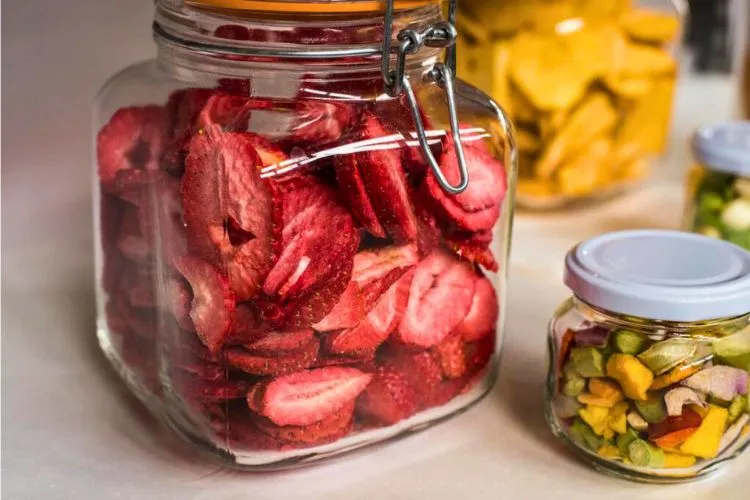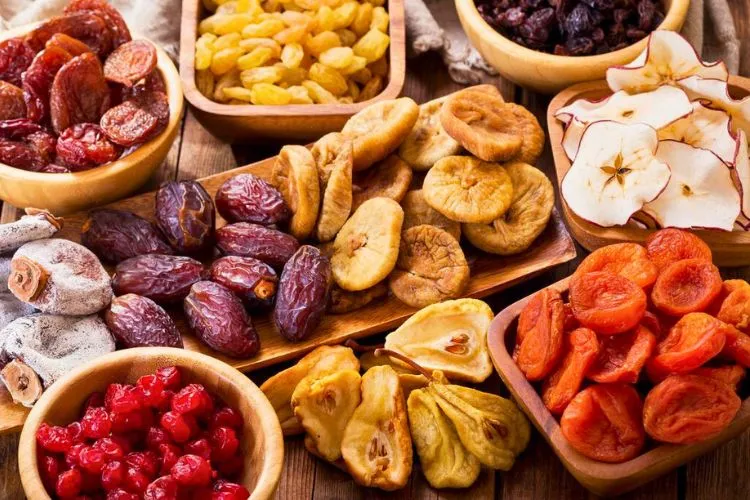Are you tired of letting your frozen fruit go to waste? Dehydrating might just be the solution you’ve been looking for.
But, can you dehydrate frozen fruit?
The short answer is yes, you can dehydrate frozen fruit, but it’s not an easy thing to do. In fact, you would need to follow multiple steps to do that.
This article explores the ins and outs of dehydrating frozen fruit, from the benefits to the challenges. I will explain all the steps so that you can do it without any hassle.

So whether you’re a seasoned dehydrating pro or a curious beginner, read on to discover everything you need to know.
Can you dehydrate frozen fruit?
Yes, dehydrating frozen fruit is possible but you need to be extra careful for that. There are some steps that needs to be done to do it effectively. It would also take almost 2 days to complete, and you need to monitor the process carefully.
- Thaw the frozen fruit: Before dehydrating, it’s essential to thaw the fruit to remove excess moisture. Thawing can be done by placing the fruit in the refrigerator at room temperature or using the defrost function of your microwave.
- Pat dry the fruit: After thawing, gently pat the fruit with a clean or paper towel to remove any remaining surface moisture. This step helps the dehydrating process and prevents the fruit from becoming too sticky.
- Pre-treat if necessary: Some fruits, like apples and pears, may benefit from pre-treatment to prevent browning. A common pre-treatment method is dipping the fruit in a lemon juice and water solution.
- Arrange the fruit on dehydrator trays: Place the thawed and dried fruit pieces in a single layer on the dehydrator trays, ensuring that they do not overlap. This allows for even airflow and consistent drying.
- Set the dehydrator temperature: The recommended temperature for dehydrating fruit is typically between 125°F and 135°F (52°C and 57°C). Consult your dehydrator’s manual for specific guidelines.
- Monitor the drying process: Dehydrating frozen fruit may take anywhere from 6 to 36 hours, depending on the type and size of the fruit, as well as the dehydrator model. Check the fruit periodically for desired texture and doneness.
- Cool and store the dehydrated fruit: Once dehydrated to your satisfaction, remove it from the dehydrator and let it cool completely. Then, store it in an airtight container, preferably in a cool, dark place, to maintain quality.
Following these steps, you can successfully dehydrate frozen fruit and enjoy a convenient, nutritious, and flavorful snack.
How to store dehydrated fruit?
To store dehydrated fruit properly and maintain its quality, follow these detailed steps:

- Cool the dehydrated fruit: After dehydration, let the fruit cool completely to room temperature before storing. This prevents condensation inside the storage container, which could lead to spoilage.
- Choose appropriate storage containers: Use glass or food-grade plastic airtight containers. Resealable bags, mason jars, vacuum-sealed bags, or plastic containers with tight-fitting lids are all suitable options.
- Label and date the containers: Clearly label the containers with the type of fruit and the date of dehydration. This helps you keep track of the shelf life and ensures that you consume the fruit within the recommended time frame.
- Store in a cool, dark, and dry location: Exposure to heat, light, and humidity can reduce dehydrated fruit’s quality and shelf life. Store the containers in a pantry, cupboard, or another dark and dry place with a stable temperature.
- Monitor storage temperature: The ideal storage temperature for dehydrated fruit is 60°F (16°C) or lower. Higher temperatures can shorten the shelf life and affect the fruit’s taste and texture.
- Check for moisture: Inspect the stored fruit every two to three weeks to ensure it remains dry and free of moisture. If you notice moisture or condensation inside the container, remove the fruit, dry it further in the dehydrator, and repackage it.
- Rotate your stock: Practice the “first in, first out” rule by consuming older dehydrated fruit before newer batches. This helps maintain freshness and prevents spoilage.
- Refrigerate or freeze for long-term storage: If you plan to store the dehydrated fruit for an extended period, consider refrigerating or freezing it in airtight containers. This can further extend its shelf life and preserve its quality.
Following these guidelines, you can store dehydrated fruit properly and enjoy its delicious taste and nutritional benefits for an extended time.
How long does dehydrated fruit last?
Dehydrated fruit can last anywhere from 4 to 12 months when properly stored. However, the quality of stored food degrades more quickly in warm temperatures and each time a container is opened, exposing the food to air and moisture.

Dried fruits such as apricots, prunes, and raisins can maintain their quality in the pantry for six months. After opening, you may wish to store them tightly sealed in the refrigerator to preserve the quality for up to six additional months or freeze them for one month.
Some dehydrated fruits can last even longer when stored in airtight packaging with oxygen absorbers and kept in a cool place, potentially lasting up to 10 to 15 years.
However, it is important to note that dried fruits usually last longer than dried vegetables, and dehydrated meat goes bad the fastest.
How long will dehydrated fruit last if vacuum-sealed?
When vacuum-sealed, dehydrated fruit can last significantly longer than stored using conventional methods. Vacuum-sealed dried fruit can last for upwards of 30 years.

However, most experts recommend storing vacuum-sealed dried fruit for 4 months to 1 year to ensure peak freshness and flavor. In addition, vacuum sealing removes air and moisture from the packaging, which helps prolong the shelf life of dehydrated fruit.
What Fruit Is Best Dehydrated?
When dried, many fruits are suitable for dehydration and can maintain their flavor, texture, and nutritional value. Some of the best fruits to dehydrate include:

- Apples: Apples are a popular choice for dehydration due to their natural sweetness and versatility. They can be eaten as a snack or used in baking and cooking.
- Bananas: Dehydrated bananas make a delicious and healthy snack. They can be eaten as banana chips or used in trail mixes and granola.
- Strawberries: Dehydrated strawberries retain their vibrant color and intense flavor, making them perfect for snacking or adding to cereal, yogurt, or baked goods.
- Peaches: Dried peaches have a sweet and tangy flavor and can be enjoyed as a snack or rehydrated in recipes.
- Pineapple: Dehydrated pineapple has a chewy texture and a concentrated sweet and tangy flavor, making it a popular choice for snacking and adding to trail mixes.
- Mango: Dried mango has a chewy texture and a rich, sweet flavor. It can be eaten on its own or added to various recipes.
- Grapes: When grapes are dehydrated, they become raisins, a popular and versatile dried fruit that can be used in baking, cooking, or eaten as a snack.
- Cherries: Dehydrated cherries have a concentrated sweet and tart flavor and can be used in various recipes, including granola, trail mix, and baked goods.
- Blueberries: Dried blueberries are a nutritious and tasty addition to trail mixes, granola, and baked goods, or they can be eaten as a snack.
- Apricots: Dehydrated apricots have a tangy and sweet flavor and are popular for snacking and cooking.
When choosing fruits to dehydrate, selecting ripe, high-quality, and blemish-free fruits is essential for the best results. Additionally, consider cutting fruits into uniform pieces to ensure even drying.
What foods can you not dehydrate?
Certain foods are unsuitable for dehydration due to their texture, composition, or high fat content. Some examples of foods that you should avoid dehydrating include:
- Raw carrots become extremely hard and difficult to digest when dehydrated. High-fat foods like peanut butter, fatty meat, breakfast sausages, avocado, and mayonnaise can spoil during dehydration.
- Researching and following proper guidelines when dehydrating food is essential to ensure safety and optimal results.
Frequently Asked Questions (FAQs)
u003cstrongu003eCan frozen strawberries be dehydrated?u003c/strongu003e
Yes, frozen strawberries can be dehydrated. Before dehydrating, thaw the strawberries and remove any excess moisture with a paper towel. Remember that the resulting texture may differ slightly from fresh strawberries due to the freezing process. However, dehydrated, frozen strawberries still make a tasty and nutritious snack or ingredient for various recipes.
Can you dehydrate frozen blueberries?
Yes, you can dehydrate frozen blueberries. First, thaw the blueberries and gently pat them dry with a paper towel to remove excess moisture before placing them on the dehydrator tray. Dehydrating frozen blueberries can result in a slightly different texture than fresh blueberries, but they retain their flavor and nutritional value.
Can frozen cherries be dehydrated?
Frozen cherries can be dehydrated successfully. First, use a paper towel to thaw the cherries and remove any excess moisture. Depending on your preference, you may need to pit the cherries before dehydrating. While the texture may differ slightly from fresh cherries, dehydrated, frozen cherries are still a delicious and versatile ingredient for various recipes and snacks.
u003cstrongu003eCan you dehydrate frozen raspberries?u003c/strongu003e
Yes, you can dehydrate frozen raspberries. Before dehydrating, thaw the raspberries and gently pat them dry with a paper towel to remove any excess moisture. The texture of dehydrated, frozen raspberries may be slightly different from fresh raspberries. However, they will still have a concentrated flavor and can be used in various recipes or enjoyed as a snack.
Conclusion:
Dehydrating frozen fruit is viable and practical for those looking to preserve and enjoy fruits year-round. While the texture of dehydrated, frozen fruit may differ slightly from that of fresh fruit, the flavor and nutritional value remain intact.
You can create delicious and versatile dried fruit snacks and ingredients for various recipes by carefully thawing and removing excess moisture from frozen fruit before dehydrating.
Dehydrating frozen fruit is an excellent way to reduce food waste, save money, and make the most of seasonal produce, ensuring that you can enjoy the taste and health benefits of your favorite fruits at any time of the year.


